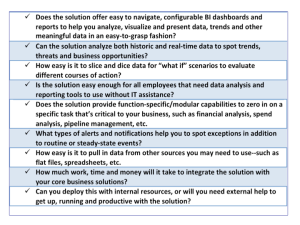Most small and medium businesses (SMBs) can relate to Albert Einstein’s famous quote that “Information is not knowledge.” Many SMBs have plenty of data, but find it challenging to get the insights from it that they need to run their businesses more effectively and efficiently.
Businesses have always needed the ability to track and measure critical success metrics in a quantifiable way. The problem is that when there’s too much information, people find it difficult to fully comprehend it and make decisions. In fact, more than one-quarter of SMBs in our 2011 SMB Routes to Market Study indicated that “getting better insights from the data we already have” as a top technology challenge.
And the problem is growing: Scientists report that more than1.2 zettabytes of digital information were created in 2010. What’s a zettabyte, you may wonder? (I know I did.) A zettabyte is 1,000,000,000,000,000,000,000 bytes–yes, that’s 21 zeroes! Online video, social networking sites, digital photography, and smart phone data are all contributing to the data pile-up. If that’s not enough to make your head spin, researchers also predict that the annual rate at which we collectively produce data will soar 44 times over the next decade.
The Gap Between BI Haves and Have-nots
Business intelligence and analytics solutions are designed to help make sense of all of this information. However, many SMBs often view these solutions as too complex and/or expensive. And companies without an accurate, consistent and accessible data source face the additional challenge of aggregating and rationalizing data from different sources.
SMB Group surveys reveal that the smaller the company, the less likely they are to use or plan to use BI solutions (Figure 1). Our 2011 SMB Routes to Market Study showed that while 33% of midsize businesses currently use and 28% plan to use BI solutions, among small businesses, just 16% currently use and 16 % plan to use BI solutions.
Figure 1: SMB Use and Plans for Business Intelligence Solutions
Source: SMB Group 2011 SMB Routes to Market Study
The danger is that relying on hunches and intuition alone can put you at risk of missing trends and market opportunities or spotting potential problems–all of which can hurt business performance.
Some of the warning signs that your company’s growth may be hampered due to an inadequate ability to analyze data are shown in Figure 2.
Figure 2: Warning Signs That Your Company Has a Data Analysis Problem
Closing the Gap
Adding a BI solution on top of disparate, inconsistent and unreliable data is like putting lipstick on a pig. So you need to start by establishing a core foundation of common, trustworthy and accessible data that’s shared across core business applications and processes. If you already run your business with an integrated business solution that pulls everything together into “one version of the truth”, you’ve already fulfilled this requirement. If not, you’ll want to integrate or upgrade the core solutions that your business relies on to ensure that you have a consistent and unified data source.
With this foundation in place, BI tools, dashboards and reports can help you to zero in on the insights you need to move your business ahead. The good news for SMBs is that several vendors now provide BI solutions tailored to meet SMB requirements and budget constraints. The bad news is that it can be difficult to figure out which one will be the best fit for your business.
While there is no “one-size fits all” solution that will be right for all companies, you can start by determining the core metrics that your business needs to measure. Many of these are likely to be areas that you need to measure and track long-term. Depending on the type of business you’re in, these could include things such as:
- The percentage of income you derive from repeat customers vs. new customers
- Times for order to ship, ship to invoice and receivables overdue
- Time to respond to and close customer service calls
- Procurement and spending analysis
- Employee turnover rate
Given the pace of change in your industry, your business goals and the overall economy, you’ll probably want to make additions and adjustments over time as well, so look for a BI solution that can adapt to your needs as they change.
Figure 3 provides a checklist of additional questions to ask as a starting point to evaluate different BI solutions.
Figure 3: Key Considerations When Evaluating BI Solutions
Getting the insights you need from a rising avalanche of information isn’t easy–but it is a critical business success factor. With the right BI tools in place, you can harness the data you have to get the wisdom you need to grow your business and stay ahead of the competition.


